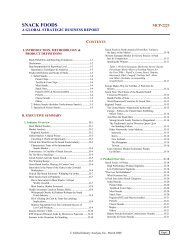the RUSSIA oil & gas competitive intelligence report - Report Buyer
the RUSSIA oil & gas competitive intelligence report - Report Buyer
the RUSSIA oil & gas competitive intelligence report - Report Buyer
Create successful ePaper yourself
Turn your PDF publications into a flip-book with our unique Google optimized e-Paper software.
Russia Oil and Gas Competitive Intelligence <strong>Report</strong> 2010<br />
new blocks stood at 462.6bcm of <strong>gas</strong> (based on Russia’s A, B and C1 classification). Although Gazprom<br />
did not disclose its output projections for Chayandinskoe, CEO Miller stated that <strong>the</strong> high helium content<br />
of <strong>the</strong> block's <strong>gas</strong> would require <strong>the</strong> construction of an expensive processing plant. Gazprom planned to<br />
bring <strong>the</strong> block onstream in 2016, <strong>the</strong> same year it plans to finish <strong>the</strong> construction of <strong>the</strong> Yakutia-<br />
Khabarovsk interconnector. The 6,000km pipeline has a design capacity of 32-35bcm per annum and<br />
aimed at eventually enabling exports of Yakutia’s <strong>gas</strong> from coastal LNG terminals.<br />
By mid-2009 Gazprom had already been awarded 14 blocks in eastern Russia without a <strong>competitive</strong><br />
tender. According to Vedomosti, Gazprom paid around RUB11bn for <strong>the</strong> blocks, which have combined<br />
reserves of 6.29trn of <strong>gas</strong> and 8bn bbl of condensate. Apart from its petition for four new Yakutia blocks,<br />
Gazprom asked <strong>the</strong> government for tax holidays and/or export duty exemptions for its eastern projects.<br />
The newspaper’s government sources claim Putin overall supported Gazprom's suggestions.<br />
Whe<strong>the</strong>r Gazprom has <strong>the</strong> need or <strong>the</strong> capacity to develop <strong>the</strong> new Yakutia permits is in question. In 2004<br />
Gazprom estimated Chayandinskoe’s reserves at 1.24tcm, over half of Yakutia’s total, and more than<br />
sufficient for <strong>the</strong> planned pipeline to <strong>the</strong> Pacific. Moreover, <strong>the</strong> impact of <strong>the</strong> recession on Gazprom's<br />
finances has already forced <strong>the</strong> company to freeze several high-profile projects in <strong>the</strong> east and north of <strong>the</strong><br />
country. In <strong>the</strong> current circumstances, Gazprom would find it difficult to fund <strong>the</strong> development of<br />
Chayandinskoe, let alone <strong>the</strong> four new Yakutia blocks it has asked for. The concessions are <strong>the</strong>refore<br />
likely to be idled for years to come.<br />
According to Vedomosti’s <strong>report</strong> in July 2009, wholly state-owned Rosneftegaz may replace Gazprom in<br />
<strong>the</strong> ownership talks for <strong>the</strong> giant Kovykta field in <strong>the</strong> eastern Irkutsk region. Nominally, <strong>the</strong> majority<br />
stakeholder in <strong>the</strong> project remains TNK-BP, but as a result of pressure from <strong>the</strong> energy ministry, for <strong>the</strong><br />
past two years <strong>the</strong> Anglo-Russian company has been negotiating <strong>the</strong> sale of its stake to Gazprom. The<br />
MoU on TNK-BP’s sale of its interest in <strong>the</strong> Kovykta operating vehicle, Rusia Petroleum, to Gazprom<br />
was signed in June 2007. In pushing for <strong>the</strong> sale, <strong>the</strong> Kremlin focused on TNK-BP's failure to raise <strong>gas</strong><br />
output at <strong>the</strong> project to <strong>the</strong> 9bcm required by <strong>the</strong> terms of <strong>the</strong> contract. This was based on <strong>the</strong> assumption<br />
that <strong>the</strong> Irkutsk authorities would comply with <strong>the</strong>ir part of <strong>the</strong> contract, building <strong>the</strong> required downstream<br />
infrastructure to channel Kovykta’s <strong>gas</strong> to local end-users. Irkutsk has failed to do this: <strong>the</strong> utilised <strong>gas</strong><br />
output at <strong>the</strong> field is by early 2009 was an annualised 30Mcm.<br />
TNK-BP's inability to raise production led <strong>the</strong> Russian subs<strong>oil</strong> agency, using somewhat perverse logic, to<br />
threaten to withdraw <strong>the</strong> Kovykta licence. It was thought that once Gazprom took <strong>the</strong> reins, <strong>the</strong> company<br />
would be likely to alter contract terms to allow exports outside Irkutsk, with <strong>the</strong> eventual aim of<br />
constructing a <strong>gas</strong> pipeline to China. It now appears, however, that Kovykta has become <strong>the</strong> latest major<br />
<strong>gas</strong> development to be shelved by Gazprom as a result of <strong>the</strong> recession. Officials at <strong>the</strong> company told<br />
Kommersant that given <strong>the</strong> current demand conditions, Gazprom would prefer to concentrate on cheaper<br />
and lower-risk projects, adding that <strong>the</strong>y were 'indifferent' towards Kovykta.<br />
© Business Monitor International Ltd Page 27









